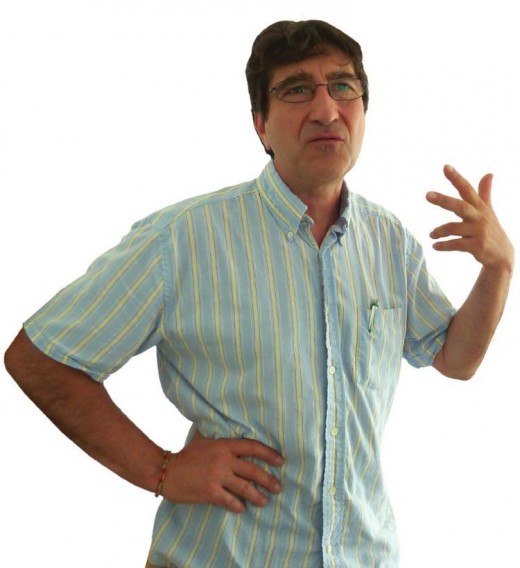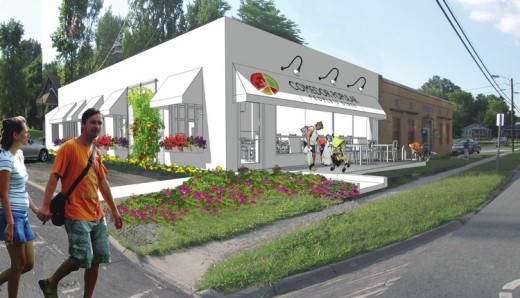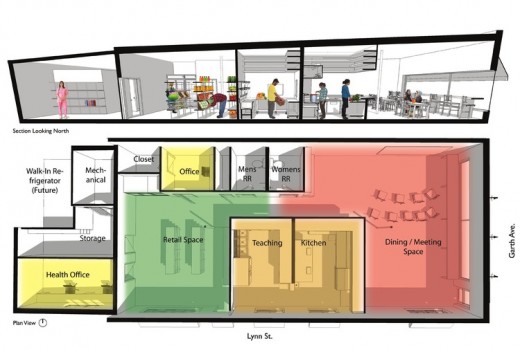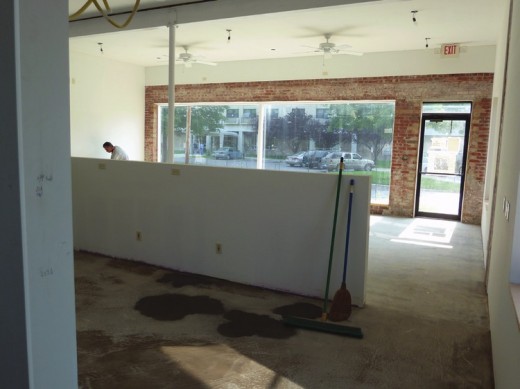Centro Latino: Relocating, Expanding Mission
Produce market, educational kitchen opening this summer
Tomato, lavender, dill, oregano, thyme and pepper plants fill the scruffy space in front of a building that will soon be the new location for Centro Latino and its latest venture — a produce market, educational kitchen and café called Comedor Popular, or the People’s Diner.
This lawn-garden at 609 N. Garth Ave., across from the looming Oak Towers, looks slightly out of place in the low-income neighborhood. Inside, the building, which used to be the home of a barbeque restaurant, is gleaming with white paint, new floors and slightly used stainless steel appliances, which volunteers will use to cook vegetarian meals using some of the produce picked from the garden. The concept is modeled after Latin American “comedores,” which cook one meal a day and sell it to the poor for a minimal price.
Eduardo Crespi started Centro Latino 11 years ago to provide a one-stop resource for Latino immigrants in central Missouri who need help acclimating to the community. Its role has grown to providing health, legal, education and social services to anyone needing help in Columbia. The move from Austin Street near the corner of Providence and Business Loop 70 to Garth and Sexton is a demonstration of the nonprofit organization’s latest mission expansion: helping all low-income residents prevent diabetes and other health problems related to obesity.

In addition to providing low-cost meals, Comedor Popular will sell fruits and vegetables grown in the center’s community garden and on Crespi’s farm, along with produce from local farmers. There also will be a kitchen, where participants will learn how to prepare the same kinds of healthy meals provided at the café. The cooking lessons will be videotaped, so people can learn the techniques online.
Crespi’s interest in health care goes back to his early years in Columbia.
Crespi moved here from Argentina, in 1991, became a citizen in 1996, a licensed practical nurse in 1997 and a registered nurse in 1999. In February, he was honored by the MU Sinclair School of Nursing, where he earned a nursing degree, with an Alumni Achievement Award for his commitment and service to the Latino community and his efforts to open the Comedor Popular.
The project’s focus on obesity stems from Crespi’s hospital experiences.
Crespi said he was deeply affected by witnessing the terrible health problems associated with obesity, particularly amputations suffered by people with diabetes, and the haunting knowledge that the tragedies can be prevented. His descriptions of people losing toes, feet and legs are vivid.
“Well for me, I saw that… I was like: ‘Whoa! What can I do to help these people not to have to go through that?’’’ Crespi said. “Well, now I’m doing it.”
In addition to teaching adults how to prepare healthy meals, Comedor Popular plans to teach children, while they are still forming their lifestyle habits, the importance of healthy eating.
“Our work is not focused on treatment,” Crespi said. “It is focused on prevention. That is what we do: prevention. That is the most challenging part of any health practice: to prevent.”
Nearly 30 percent of Boone County’s adult population is obese, with a body-mass index greater than 30, according to a recent County Health Rankings study. About 10 percent of the area’s children are overweight or obese, and almost twice as many have a risk of becoming overweight or obese, according to Maureen Coy, a health educator with the Columbia/Boone County Department of Public Health and Human Services.
Stacia Reilly, health promotion coordinator for the department, said obesity problems can be prevented if kids develop healthy habits and have access to fruits and vegetables.
Crespi hopes that what he teaches the children will influence the way the entire family eats.


As Crespi described the center’s prevention programs while standing in the room that will soon be the neighborhood wellness center, a small group of neighborhood kids began to pass the front window. Crespi greeted them with a smile and a wave, as he did with neighborhood adults who walked by.
Crespi, who said he hopes to see many of the neighbors inside this summer, operates with amazing optimism.
For example, the renovation of the building, estimated to cost $100,000, has been under way for two years, but the purchase of the building won’t be final until July 31. Part of the $140,000 purchase will be funded by a Community Development Grant, which is still awaiting approval by Columbia City Council. The amount Crespi hopes for is $88,000, but as Tom Lata, community development coordinator for the city’s Department of Planning and Development noted, that amount could be cut.
Lata said the most surprising thing about the project is that despite the uncertainty, Crespi went ahead on improvements to the building, something he said he’s never seen before.
“For the city, it’s a good deal” because the building had been an eyesore, Lata said. “It’s worth a whole lot more now than it was before.”
Crespi said he isn’t worried. The center has a lease with building owner Dudley Roth, and Crespi had his heart set on that particular property at a key crossroads.
Opening date uncertain
Crespi said he hopes Comedor Popular is open when the organization takes ownership of the building in July but said he doesn’t know for sure.
Part of the uncertainty stems from the shoestring budget of an operation dependent mainly on volunteers. The building project is also dependent on volunteer labor people and on donations, including the roughly $25,000 the Centro has received in in-kind donations from 20 sources during the two-year course of renovating the building.
The in-kind donations have ranged from architectural help from Adrienne Stolwyk of Peckham & Wright Architects and mechanical work by Projects Solutions Engineering to an impromptu discount on sheets of drywall from the vendor once he heard that the drywall was being purchased with $500 from a carwash held by the Hickman High School Spanish class. Centro Latino plans to hold a Comedor Popular fundraiser this summer.
Crespi’s connections to a wide variety of people throughout Columbia have helped him keep the center going with volunteers and grants, but mainly through his own grit and determination.
Crespi didn’t receive a salary from Centro Latino for three years and then got paid through a grant the center received from the local health department for the Latino Link Program. Now Crespi’s salary as director is paid through yet another grant, this one from the Missouri Foundation for Health.
Although Centro Latino’s finances are healthy today, it has been Crespi’s connections within the community and a willingness to expand the mission and services that have allowed the nonprofit to stay open and effective even when funding dipped from $53,098 in 2003 to a low of $28,212 in 2005 and then to a high of $175,924 in 2010. The center is on track to bring in about $100,000 in 2011, Crespi said.
How Crespi manages to keep Centro Latino afloat is a mystery, even to longtime associates.
“I have no idea how they (nonprofits such as Centro Latino) support themselves,” said Steve Jeanetta, a state specialist in community development process at the University of Missouri who has been working with Crespi and Centro Latino for more than six years.
It’s not that the financial documents are not available — they are. Anyone can check out guidestar.com and see all of Centro Latino’s IRS documents any time, including an auditor’s report giving the 501(c)3 nonprofit organization a clean bill of health as well as advice to tighten its financial controls. It’s just that even when funding dries up, as it nearly has several times, volunteers continue to do the work, said Jeanetta, who has experience with several similar nonprofits.
Christiane Quinn, who joined the Centro Latino board last August to keep a closer eye on the books in response to the auditor’s suggestion, put it this way: “He (Crespi) comes up with a problem, he jumps over it and continues.”
Sometimes it is even difficult to figure out who is working there and who isn’t. As Quinn pointed out, because the funding is mainly through grants, people may be working on the projects at other locations and not at the organization’s office. Then there’s the problem of figuring out who is a volunteer and who is on the payroll because people often continue to work on a project even after the funding ends.
Although Jeanetta isn’t sure how Centro Latino stays open, he is certain that its Promotoras de Salud (Educators of Health) project, funded by a Missouri Foundation for Health grant, works.
His research showed of the 351 participants who used the promotoras to access health care resources, 89 percent followed through with the prescribed treatments. This is important, he said, because without such help, they typically don’t know what to do or how to follow through with health care recommendations. He noted the majority of those who did not follow through did not have the resources to acquire the necessary medication.

A review of YouTube video reveals the breadth and depth of Crespi’s efforts: Crespi on a tractor in the countryside, plowing land to raise vegetables; Crespi videotaping a kid’s field trip; Crespi turning the soil at the community garden plot; Crespi making a Health Promotoras presentation on diabetes prevention.
Much of what happens depends on Crespi and his ability to keeping the center and his volunteers going. During a tour of the new building, Crespi looked up, admiring the bright white expanse of ceiling, pockmarked with holes for future lighting fixtures. “Not bad,” he said, adding that one hole was covered by mistake when they were finishing the job at 3 a.m.
But Crespi is eager to point out it is not just his efforts that keep the organization going. “Three board members teach the ESL (English as a Second Language) classes, and we have a Spanish teacher who has been teaching at Centro for three years. There are lots of people involved and working hard at Centro Latino,” Crespi wrote in an email.
Jeanetta also noted that Centro Latino attracts many small projects, “such as a student doing a research project for a class, someone looking for a job or an organization that wants to get feedback from Latinos on an issue. …” These projects, the MU researcher said, “are often as important as some of the larger projects because they build the relationships in the community that make the other things possible.”
Both Centro Latino’s community partnerships and program offerings are expansive: Missouri Foundation of Health, the Columbia/Boone County Health Department, Columbia Public Schools and 4-H; and the MU-affiliated Center for Health Policy, Extension, Cambio Center and MedZou student clinic. Along with the health programs, there are English classes on Monday nights and after-school and summer programs for children, Kids in the Kitchen and some services offered for fees such as interpreting, translation, Spanish classes and immigration services.
But with so much going on, isn’t it difficult to keep track of what everyone is doing and how everything is funded? Not for Crespi, according to Marvin Rogers, an MU professor emeritus of political science and president of the Centro Latino’s board. “It’s all in Eduardo’s head,” Rogers said. “Eduardo is a remarkable person, and the Centro is flourishing.”
With a wry smile, Crespi said this about his independence: “I create my own stress, I might as well enjoy it.”
“He’s stubborn,” Jeanetta said, “but he gets a lot done.”

Crespi acknowledges that he’d like to move away from such dependency on grants. The amount the center takes in for interpreting, translation, immigration services and Spanish classes has increased from $1,280 in 2007 to $9,839 in 2010. But this is still a minuscule amount compared to the roughly $30,000 it takes to run the center, according to Crespi.
The Comedor Popular will sell meals at a low cost, income that will help to offset the program’s costs. The fruit and vegetable market contributed roughly $500 to the center’s income last year, an amount Crespi expects to see increase this year.
“I’m looking for a product to create cash flow,” he said, “while I look for the pennies.”
Yet, the question remains: Will people change their diet through his efforts? Crespi is convinced they will and that Jeanetta’s research will prove he’s right.
Jeanetta, too, thinks the program will work; participants will learn more about food they eat through the programs offered by the Comedor Popular.
“Many do not know that the foods they eat here, that are similar to what they eat from the countries they come from, contain much more sugar,” Jeanetta said.
Yet, he knows there are people who will decide that Crespi’s ideas are crazy and few will become vegetarian like Crespi. But, he added, “They’ll change something because they trust him.”


